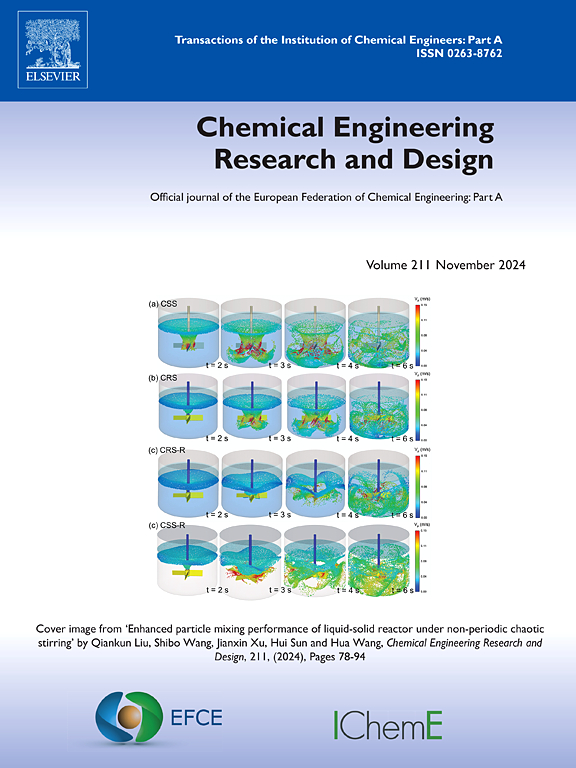Numerical hydrodynamic characterization for the design of a lab-scale jet-loop reactor
IF 3.9
3区 工程技术
Q2 ENGINEERING, CHEMICAL
引用次数: 0
Abstract
The jet-loop reactor is a powerful tool for analyzing the kinetics of heterogeneous catalytic reactions due to its high mixing degree. Indeed, the high momentum gas flow injected within the loop induces a large gas recycling flow, minimizing concentration and temperature gradients. The purpose of this numerical study is to optimize the geometric features of the reactor (injection nozzle diameters and length, and outlet pipe diameter) to improve the gas recycle ratio. Its hydrodynamic behavior is predicted by using multi-fluid solver, with an immersed boundary method to model the injector and easily vary its geometry. The effects of the operating parameters such as the injection flowrate, the pressure and the temperature are also assessed. In addition, a residence time distribution analysis allows for the evaluation of the Péclet number as a function of the geometric and operating parameters of the reactor. Then, a zero-dimensional hydrodynamic model, based on a macroscopic momentum balance, is finally developed. After fitting specific terms thanks to separated numerical CFD simulations, it enables a rapid optimization of the reactor design and provides insights into its behavior.
实验室规模射流回路反应器设计的数值流体动力学表征
射流环反应器因其高混合度而成为分析非均相催化反应动力学的有力工具。实际上,在回路内注入的高动量气流诱导了大量的气体再循环流量,使浓度和温度梯度最小化。本次数值研究的目的是优化反应器的几何特征(喷嘴直径和长度、出口管径),以提高气体再循环比。它的流体动力学行为是用多流体求解器来预测的,用浸入边界法来模拟喷油器,并且容易改变其几何形状。同时,对注射流量、压力和温度等操作参数的影响也进行了评价。此外,停留时间分布分析允许将psamclet数作为反应器的几何和操作参数的函数进行评估。最后,建立了基于宏观动量平衡的零维水动力模型。通过单独的数值CFD模拟,在拟合特定条件后,可以快速优化反应器设计,并深入了解其行为。
本文章由计算机程序翻译,如有差异,请以英文原文为准。
求助全文
约1分钟内获得全文
求助全文
来源期刊

Chemical Engineering Research & Design
工程技术-工程:化工
CiteScore
6.10
自引率
7.70%
发文量
623
审稿时长
42 days
期刊介绍:
ChERD aims to be the principal international journal for publication of high quality, original papers in chemical engineering.
Papers showing how research results can be used in chemical engineering design, and accounts of experimental or theoretical research work bringing new perspectives to established principles, highlighting unsolved problems or indicating directions for future research, are particularly welcome. Contributions that deal with new developments in plant or processes and that can be given quantitative expression are encouraged. The journal is especially interested in papers that extend the boundaries of traditional chemical engineering.
 求助内容:
求助内容: 应助结果提醒方式:
应助结果提醒方式:


